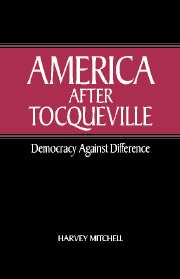Book contents
- Frontmatter
- Contents
- References to Tocqueville's Democracy in America
- Preface
- I PATHS TO DEMOCRACY IN AMERICA
- 1 Introduction: Thinking about American Democracy
- 2 Democracy's Experiment: From Inequality to Equality
- 3 Achieving a Democratic Civil Society
- II BEGINNINGS AND DEMOCRACY
- III AMERICAN DEMOCRACY ON TRIAL
- 10 Conclusion
- Works Cited
- Index
3 - Achieving a Democratic Civil Society
Published online by Cambridge University Press: 10 August 2009
- Frontmatter
- Contents
- References to Tocqueville's Democracy in America
- Preface
- I PATHS TO DEMOCRACY IN AMERICA
- 1 Introduction: Thinking about American Democracy
- 2 Democracy's Experiment: From Inequality to Equality
- 3 Achieving a Democratic Civil Society
- II BEGINNINGS AND DEMOCRACY
- III AMERICAN DEMOCRACY ON TRIAL
- 10 Conclusion
- Works Cited
- Index
Summary
The tensions between equality and liberty, as well as those between liberty and authority, counted as the markers of a democratic civil society, but the science of politics lay in isolating those institutions that gave it practical life. This was the project to which Tocqueville devoted his observing eye and intellectual energies. What made Americans behave as a people sharing common interests paradoxically had almost every-thing to do with their sense of themselves as sovereign individuals. Thus, one of the features of American civil society that Tocqueville explored was its deep roots in the tradition of communal and mutual helpfulness, and the sharing in tasks through the voluntary associations that he said were stronger in America than even in England. How this was achieved was one of the mysteries that Tocqueville tried to penetrate. There were the political associations, also founded in English political traditions, that sought to enlist partisan support for political programs. The relationship between politics and the power of public opinion was an integral part of American democracy as well. Finally, the role that religion played in securing the fabric of civil society had properly to be defined. Taken together, these elements revealed much, he claimed, about the American experiment. We will look at each of them.
Some Contrasting Conceptions of Civil Society
We might begin first with another, a rather distant, vision of a civil society, a pre-modern democratic one, for it sharpens the outlines of Tocqueville's modern one.
- Type
- Chapter
- Information
- America after TocquevilleDemocracy against Difference, pp. 49 - 72Publisher: Cambridge University PressPrint publication year: 2002



